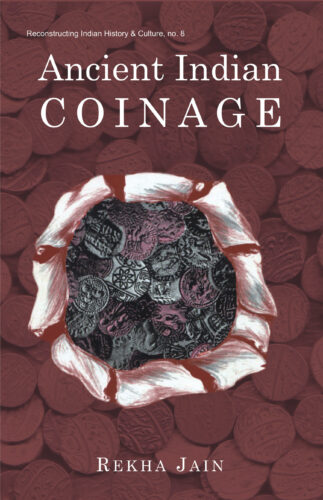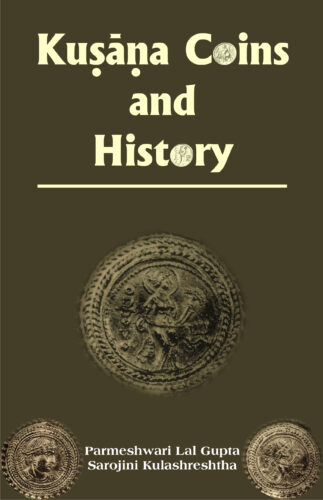Showing all 3 results

This book studies ancient Indias monetary economy in terms of its coinage through six successive periods from the janapadas to the pre-medieval. It establish linkages between the ancient coins and their references in ancient texts.
Money is unmistakably a landmark invention considering its indispensable role in economics and, more specially, in the commercial sphere of mans existence anywhere in the world. However, we have yet to have final answers to some of the fundamental questions: When, where, and how was money shaped as coins or as pieces of stamped metal first introduced to human civilization? Its genesis in India is traced back to the sixth century bc: during the second urban revolution, when coins came to be manufactured here independently, indigenously. Analysing in depth an astonishing mass of numismatic and kindred data, published in different catalogues, archaeological reports, journals and elsewhere, this book investigates the evolution of ancient Indias money economy: in terms of its coinage, through six successive periods: janapada, Maurya, post-Maurya, Gupta, post-Gupta, and pre-medieval which, in their togetherness, span nearly two millennia. Covering the entire subcontinental sprawl, Dr. Jain considers the whole variety of coins: local, universal standard, and even foreign, with meticulous descriptions of coin types, symbols, legends, fabric and metrology. In her thematic effort to reconstruct the history of ancient Indian coinage (and, thus, money economy), from its first beginnings in high antiquity to about the twelth century ad, the author has drawn on wide-ranging primary and secondary sources. And has also tried to establish linkages between different ancient coins and their references/descriptions in Vedic/Buddhist/Jaina texts, Paninis Ashtadhyayi, Kautilyas Arthashastra, epical literature, Dharmashastras, foreigners travelogues, old-world mathematical treatises, and numerous contemporary inscriptions, among others writings.

This book studies ancient Indias monetary economy in terms of its coinage through six successive periods from the janapadas to the pre-medieval. It establish linkages between the ancient coins and their references in ancient texts.
Money is unmistakably a landmark invention considering its indispensable role in economics and, more specially, in the commercial sphere of mans existence anywhere in the world. However, we have yet to have final answers to some of the fundamental questions: When, where, and how was money shaped as coins or as pieces of stamped metal first introduced to human civilization? Its genesis in India is traced back to the sixth century bc: during the second urban revolution, when coins came to be manufactured here independently, indigenously. Analysing in depth an astonishing mass of numismatic and kindred data, published in different catalogues, archaeological reports, journals and elsewhere, this book investigates the evolution of ancient Indias money economy: in terms of its coinage, through six successive periods: janapada, Maurya, post-Maurya, Gupta, post-Gupta, and pre-medieval which, in their togetherness, span nearly two millennia. Covering the entire subcontinental sprawl, Dr. Jain considers the whole variety of coins: local, universal standard, and even foreign, with meticulous descriptions of coin types, symbols, legends, fabric and metrology. In her thematic effort to reconstruct the history of ancient Indian coinage (and, thus, money economy), from its first beginnings in high antiquity to about the twelth century ad, the author has drawn on wide-ranging primary and secondary sources. And has also tried to establish linkages between different ancient coins and their references/descriptions in Vedic/Buddhist/Jaina texts, Paninis Ashtadhyayi, Kautilyas Arthashastra, epical literature, Dharmashastras, foreigners travelogues, old-world mathematical treatises, and numerous contemporary inscriptions, among others writings.

Dr. P.L. Gupta examines myriad coins of the Kusanas to convincingly resolve the chronological puzzles of these Indo-Scythian kings from their rise in mid-2nd century ad to their extinction in ad 370.
The scions of a Central Asias nomadic tribe, (called Yueh-chi), KUSHANAS descended upon the plains of northern India sometime around the first century after Christ. And gradually built a great, vastly extensive empire in the Yamuno-Gangetic region. But, owing to a marked deficiency of indigenous literary sources, Kushana history has continued to be the sport of conjecture. Or, for the last 200 years or so, an area of chroniclers debate, involving scholars: both Indian and European. A numismatist of international renown, Dr. P.L. Gupta examines myriad coins of the Kushanas, including some of the very recent finds, to convincingly resolve the chronological puzzles of these Indo-Scythian kings: from their very rise in mid-second century ad to their final extinction in circa 370 ad. Corroborating the conclusions of his lifetime research on coins, with inscriptional material, he elicits fresh evidence on various important aspects of Kushana history: ranging from span of their era to the domains of their political authority. Barring the inclusion of two papers, written by Dr. Sarojini Kulashreshtha, this volume is an exquisite presentation of Dr. Guptas writings on numismatics and related historical aspects. Now offered with highly representative visual material, extensive bibliographic references, and an elaborate introduction, these papers, when pieced together, evolve a stimulating framework for the scholars working on Kushana history.
| There are no products |